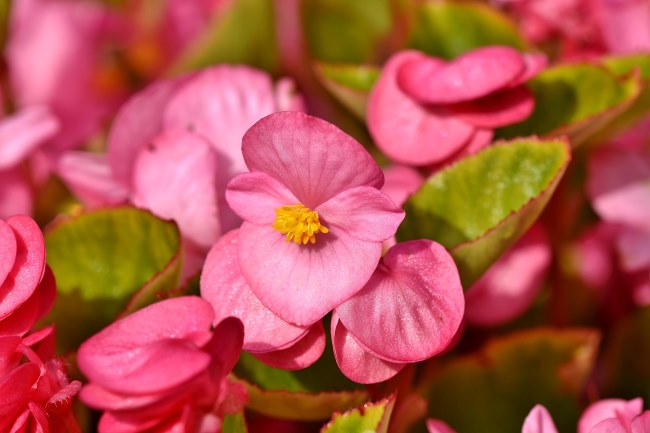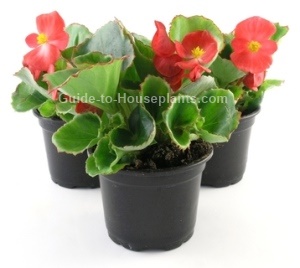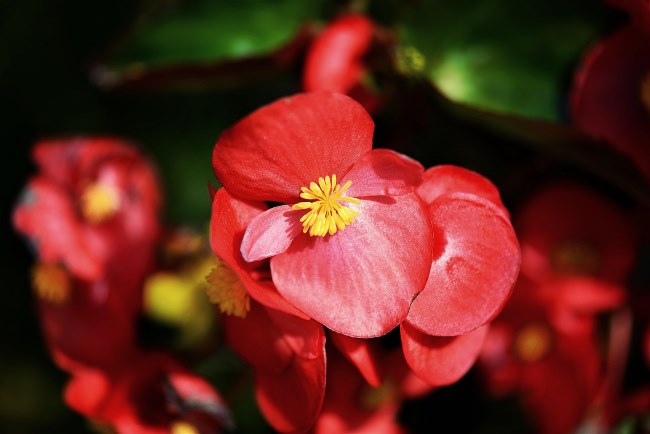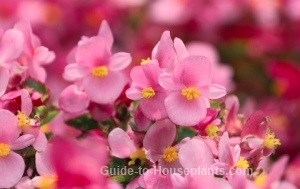Wax Begonia
Botanical Name: Begonia x semperflorens-cultorum
Few indoor plants bloom nearly non-stop like wax begonia. It's actually a tender perennial that will grow and flower year-round indoors. Put your begonia in a bright, warm spot and you'll enjoy an ongoing show of colorful, cheerful flowers.

About Wax Begonia Plants
The begonia family includes more than 1,000 species and 10,000 hybrids and cultivars. Ongoing hybridization improves these beautiful flowering house plants. Newer hybrids are more compact with more -- and bigger -- blooms than we've ever seen.
Many varieties are available with white and many shades of pink and red flowers. When buying a new flowering plant, choose one that has good bud color and has just started to bloom. You'll find these plants sold as wax begonia or bedding begonia.

Round, thick, waxy leaves give this beautiful flowering plant its common name. They're typically dark-green and may be tinged with bronze. Some hybrids have burgundy leaves or are variegated with white.
These prolific bloomers stay small, so grow several in a large pot for big impact. Or place a few small pots together.
Caring for Wax Begonia Indoors: Solutions and Special Helps
Keep the soil moist. Allowing it to dry out will leave it susceptible to disease. But you don't want soggy soil, either. Overwatering your begonia will cause leaves to wilt and turn yellow. Cut off any affected leaves as soon as you notice them. They're likely to rot and attract fungus.
Brown leaves? Cool temps and soggy soil will cause leaves to become soft and turn brown. Cut off brown, wilted leaves because they may attract fungus.
Watch for fungus. The moist conditions begonias love make them prone to powdery mildew -- a powdery white fungus that appears on the foliage. Spray an affected plant with a fungicide and keep it away from other plants to prevent it from spreading.
Shed some light. Give your begonia plenty of bright light year-round. Plants that don't bloom aren't getting enough sunlight.

Prune your plant. Remove spent flowers to encourage more blooms. Also cut back the foliage occasionally to keep it looking neat.
Raise the humidity. Begonias will suffer in the dry air of a heated home in winter. Keep them away from air vents and drafts. If the relative humidity drops below 50%, place your begonia on a tray of wet pebbles or use a cool-mist room humidifier.
Repot in spring. Move your wax begonia to a slightly larger pot, if it is getting top-heavy or if you see roots growing through the drainage hole in the bottom. Use a pot that's only 1-inch (2.5 cm) bigger than the old one. Begonias bloom best when their roots are a little snug in the pot, so you'll get more flowers this way. When potting your begonia, don't pack down the potting mix; keep it loose around the plant's roots.
Wax Begonia Care Tips

Origin: Hybrids
Height: 6-12 in (15-30 cm)
Light: Bright, indirect light. Begonias grow well under fluorescent lights, too. If you move your begonia outdoors for the summer, keep it shaded from hot, direct sun.
Water: Keep soil evenly moist all year. Overwatering will cause leaves to turn yellow. Use a pot with a drainage hole and allow top 1-inch (2.5 cm) of the potting mix to dry before watering again.
Humidity: Try to maintain 40-50% relative humidity around your begonias. Keep pot on a tray of wet pebbles to increase humidity.
Temperature: Cool nights (60°F/16°C) and warm days (65-75°F/18-24°C) will trigger flower buds. Begonias will tolerate a minimum winter temperature of 55°F/13°C. If you moved your plant outdoors for the season, overwinter it indoors.
Soil: Peat moss based potting mix with added perlite for faster drainage. African violet potting mix is ideal.
Fertilizer: A steady diet of weak fertilizer will keep begonias happy. Feed monthly with a high-phosphorus (10-20-10 NPK) water-soluble fertilizer diluted by half.
Propagation: Take 3- to 4-inch (8-10 cm) stem cuttings in spring and root in fresh potting mix. Keep soil lightly moist. Cover the whole container and plant with a plastic bag or cloche to hold in humidity. Wax begonia seeds are tiny and slow to germinate. You can sow seeds in spring, but they can take several months to grow and bloom.


